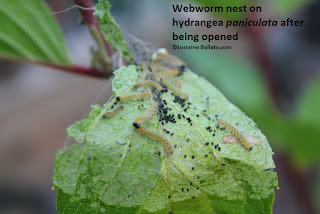HYDRANGEA CARE FOR JULY
If your garden is anything
like mine, right about now insects and disease start rearing their ugly heads.
In most cases, they show up as a result of cultural conditions. Here’s the low
down on what I am seeing right now which may match what’s happening in your
garden as well.
We had a very wet and cool
spring and things have finally begun to dry out. But all that rain and lack of
ultraviolet light have left their mark. I am starting to see something called interveinal chlorosis on both my
bigleaf hydrangeas (macrophylla) and
oakleaf hydrangeas (quercifolia).
This is what the oakleaf tissue looks like.
Exactly what is interveinal chlorosis? It’s what
happens when the plant can get enough chlorophyll (the stuff that makes it
green) to the leaves. How does that happen? It goes back to the plant’s need
for iron to make chlorophyll, which is why most people think it’s a simple lack
of iron. They apply a foliar spray to their plant to “green it up.” But you
already know that much is not simple with this plant. Be aware that this immediate
result doesn’t solve the chlorosis. It just treats the symptom of whatever is
happening in your soil. It’s up to you to figure out the issue in the soil
chemistry, maybe with a little help from your local cooperative extension
office or a reputable garden center.
There are several causes
of chlorosis. Your first step is to do a soil test since an out-of-balance pH
can cause this condition. If it’s your pink-flowered bigleaf hydrangea, your soil might be too
alkaline. When that happens, the iron is less available to the plant. Your
ideal pH for a pink flowering hydrangea should be in the range of 6.0-6.2. An
amendment of aluminum sulfate can bring that pH down. The label on your product
will give you all the info you need to do the job correctly. Once the pH is
adjusted, the iron in the soil will be more available to the plant.
But
if pH isn’t your problem, then what is causing this chlorosis? It could be that
the ground is too wet. Excessive moisture in the soil inhibits root development
and that leads to the plant not being able to properly grow and again, use
what’s in the soil for its development. Try and check the roots of your
affected plant to be sure it’s not suffering from the excess rain and irrigation. Anything wetter than damp isn't a good situation.
Other causes can be traced to deficiencies of manganese or zinc. How do you know which is the culprit? Inspect the leaves to determine what foliage turned chlorotic first. Iron chlorosis starts on the younger or terminal leaves and later works inward to the older leaves. That's what I have on my oak leaf. Manganese and zinc deficiencies on the other hand develop on the inner/older leaves first. Plus your soil test will tell you what’s what so you can take the proper action.
The other issue I’m seeing on my panicle hydrangeas (paniculata) is webworms. They have begun to form their webs and rear their young within those webs. This is an easy one to address, but you must pay attention to your plants as this webworm activity will continue as the season moves along. This is what some foliage on one of my plants looked like when I discovered the webs:
 |
| Webworm nest on hydrangea paniculata |
You can cut off the stem with the web on it and put it in the trash, not a compost pile. However, if you’re like me, you want to have as many flowers as possible. In that case, fix the problem mechanically. Break open the web and expose the worms to make a tasty meal for your birds.
 |
| Webworm nest on hydrangea paniculata after being opened |
 |
| Webworm nest on hydrangea paniculata having a panic attack |
You can snip off the damaged leaves and keep your flower at the tip of the stem for later enjoyment.
If you must apply an insecticide, know that the one to use is bacillus thuringiensis subspecies kurstaki (Btk), not Spinosad. Btk is the one that is effective on members of the moth family. Keep in mind that although Btk is an organic treatment, it is lethal to the caterpillars in the webworm nest and that other caterpillars can be impacted, including caterpillars that turn into butterflies. Just another reason to use a mechanical approach.
Like all organic products, Btk is ineffective when it dries and only works on contact with the caterpillar: it must be ingested. You can’t spray preventively; you must target the caterpillar.
These are minor fixable issues that you can easily scout and treat now that you know more about them.
I do hope that you are enjoying your hydrangeas. Mine are gradually opening to add stunning beauty and enjoyment to the garden, proving that flowering hydrangeas are a reality, not a myth!
On another note, for anyone vacationing in the Cape Cod area for the next few weeks, be sure to visit the open gardens as part of their annual hydrangea festival. You'll love seeing them in this fabulous growing climate.




